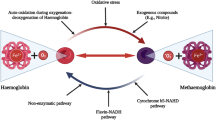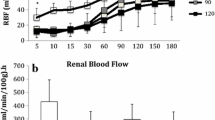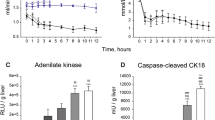Summary
Intracellular enzyme activities can be greatly influenced by alterations of pH, and non-physiologic pH may inhibit cell metabolism. The study was undertaken to examine the influence of pH values in preservation solution on ischemic tolerance time of the liver.
BDE rat livers were used. Livers were preserved for 20 min or 2 h in warm ischemia after an initial perfusion with Ringer's solution at pH 9.0, 7.4, and 6.0. The values of total adenine nucleotide (TAN) and energy reserve (ER) in the livers were determined at the end of the preservation. After 20 min of warm ischemia, TAN values at pH 9.0 and 7.4 fell to 2.727 ± 0.255 and 2.410 ± 0.164 µmol/g, respectively (normal values: 3.414 ± 0.270 µmol/g) and ER values to 0.786 ± 0.186 µmol/g at pH 9.0 and to 0.446 ± 0.095 µmol/g at pH 7.4 (normal values: 2.962 ± 0.214 µmol/g). A similar trend was also observed after 2 h of warm ischemia. The preservation with a solution at pH 6.0 did not present any difference as compared to that at pH 7.4. Four-hour preservation in cold ischemia with Ringer's solution at pH 9.0 rendered higher values of TAN (2.635 ± 0.085 µmol/g) and ER (0.336 ± 0.026 µmol/g) than those in preservation at pH 7.4. No significant difference between TAN and ER values was found when 4-h preservation at pH 7.4 and 6.0 was compared.
In another group an intermittent liver perfusion at 1-h interval was performed with chilled Ringer's solution; afterwards GOT, GPT,β-glucuronidase, and acid phosphatase values in the effluents were evaluated. All of these enzymes showed higher concentration in the effluent with solution at pH 7.4 than that at 9.0. These results suggested that better intracellular energy reserve and organ viability can be maintained by preservation with alkaline solution. Furthermore, ER values seemed to be an excellent indicator of the organ viability during preservation. These were also confirmed by orthotopic hepatic transplantation in pigs. Livers were successfully preserved with alkaline Ringer's solution for up to 12 h. However, without change of pH, livers could not be preserved for more than 4.5 h.
Zusammenfassung
Intrazelluläre Enzymaktivitäten können durch differente pH-Werte alteriert werden, und eine Verlangsamung des Zellmetabolismus durch nicht physiologische pH-Werte erscheint möglich. Um diesen Einfluß bei der Organkonservierung zu prüfen, wurden Konservierungslösungen der Leber untersucht.
Als In-vitro-Tests verwendeten wir BDE(RT 1u)-Lebern, die nach Initialperfusion mit Ringerlösung von pH 9,0; 7,4 und 6,0 20 min sowie 2 h in warmer Ischämie belassen wurden. Anschließend wurden die Gesamtnukleotide (TAN) und die Energiereserve (ER) bestimmt. Nach 20 min fielen die Werte bei pH 9,0 auf 2,272 ± 0,255 µmol/g, bei pH 7,4 auf 2,410 ± 0,164 µmol/g ab (Normalwert: 3,414 ± 0,270 µmol/g). Die ER-Werte fielen auf 0,786 ± 0,186 µmol/g bzw. 0,446 ± 0,095 µmol/g (Normalwert: 2,962 ± 0,214 µmol/g). Ein homologer Verlauf wurde auch nach 2 h warmer ischämie beobachtet. Jedoch fanden wir keine Unterschiede bei der Verwendung von Konservierungslösungen mit pH 7,4 und 6,0. Bei einer vierstündigen Konservierung in kalter Ischämie zeigte die Lösung mit einem pH von 9,0 höhere Werte sowohl bei TAN (2,635 ± 0,085 µmol/g) als auch bei ER (0,336 ± 0,026 µmol/g), verglichen mit pH 7,4. Hier fanden wir auch keine signifikanten Unterschiede zwischen den Werten bei pH 7.4 und 6.0.
In einer weiteren Gruppe wurde eine intermittierende Perfusion der Leber in einstündigem Interval durchgeführt; anschließend GOT, GPT, saure Phosphatase undβ-Glucuronidase in den Effluaten bestimmt. Alle Enzyme fanden sich in höheren Aktivitäten in den Effluaten der Konservierung mit pH 7,4 als mit pH 9,0. Diese Resultate lassen vermuten, daß eine bessere intrazelluläre ER und weiterhin Organvitalität durch alkalinisierte Konservierungslösungen aufrecht erhalten werden können. Weiterhin erwiesen sich die ER-Werte als ausgezeichnete Indikatoren der Transplantatvitalität bei der Organkonservierung zur Transplantation.
Die obigen Ergebnisse wurden bestätigt durch die orthotope Lebertransplantation beim Schwein. Mit alkalinisierter Ringerlösung konnten die Lebern bis zu 12 h erfolgreich konserviert werden, ohne pH-Alteration nicht länger als 4,5 h.
Similar content being viewed by others
Literatur
Abouna GM, Koo CG, Howanitz LF, Ancarani E, Porter KA (1971) Successful orthotopic liver transplantation after preservation by simple hypothermia. Transplant Proc 3:650–653
Adam H (1965) Adenosine-5′-diphosphate and adenosine-5′-monophosphate. In: Bergmeyer HU (ed) Methods of enzymatic analysis. Academic Press, New York, pp 573–577
Benichou J, Halgrimson CG, Weil R III, Koep LJ, Starzl TE (1977) Canine and human liver preservation for 6 to 18 h by cold infusion. Transplantation 24:407–411
Bore PJ, Papatheofanis I, Sells RA (1979) Adenosine triphosphate regeneration and function in the rat kidney following warm ischemia. Transplantation 27:235–237
Brettschneider L, Dalzoe PM, Porter KA, Groth CG, Hutchinson DE, Starzl TE (1968) The use of combined preservation techniques for extended storage of orthotopic homografts. Surg Gynecol Obstet 126:263–274
Calman KC (1974) The prediction of organ viability. Cryobiology 11:1–6
Calne RY (1969) Liver transplantation. Transplant Rev 2:69–89
Calne RY, Dunn DC, Herbertson BM, Gordon EM, Bitter-Suermann H, Robson AJ, Macdonald AS, Davis DR, Smith DP, Reitter FH, Webster LM (1972) Liver preservation by single passage hypothermic “squirt” perfusion. Br Med J 21:142–144
Calne RY (1974) Liver preservation. Discussion. In: Lie TS, Gütgemann A (eds) Liver transplantation. Witzstrock, Baden-Baden, pp 170–171
Collins GM, Taft P, Green RD, Ruprecht R, Halasz NA (1977) Adenine nucleotide levels in preserved and ischemically injured canine kidney. World J Surg 1:237–243
Collste H (1972) Preservation of kidneys for transplantation. Experimental studies. Acta Chir Scand [Suppl] 425:31–37
Fredlung PE, Öckerman PA, Vang JO (1974) Acidosis and increased plasma levels ofβ-d-glucuronidase andβ-d-galactosidase after hepatic inflow occlusion in the pig. Acta Chir Scand 140:234–241
Janoff A, Weissmann G, Zweifach BW, Thomas L (1962) Pathogenesis of experimental shock. IV. Studies on lysosomes in normal and tolerant animals subjected to lethal trauma and endotoxinemia. J Exp Med 116:451–466
Kestens PJ, McDermott WV (1961) Perfusion and replacement of the canine liver. Surgery 50:196–206
Lambotte L, Pontegnie-Istace S, Otte JB, Kestens PJ (1974) The effect of isoproterenol and Collins' solution on the preservation of canine livers with simple cooling. Transplant Proc 6:301–303
Lamprecht W, Trautschold I (1965) Adenosine-5′-triphosphate. Determination with hexokinase and glucose-6-phosphate dehydrogenase. In: Bergmeyer HU (ed) Methods of enzymatic analysis. Academic Press, New York, pp 543–551
Lie TS, Totovic V, Lagace G, Lee KS, Last R (1973) Einfache Methoden zur Konservierung der Schweineleber. II. Initialperfusion und Hypothermie. Res Exp Med (Berl) 160 248–251
Lie TS, Käufer M, Siedek CH, Prange K, Rommelsheim B, Fillmann B, Gütgemann A (1974) Verlängerte ischämische Toleranzzeit der menschlichen Leber mit erfolgreicher Transplantation. Münch Med Wochenschr 116:1013–1020
Nördlinger B, Douvin D, Javaudin L, Bloch P, Aranda A, Boschat M, Huguet C (1980) An experimental study of survival after two hours of normothermic hepatic ischemia. Surg Gynecol Obstet 150:859–864
Raffucci FL, Wangensteen OH (1950) Tolerance of dogs to occlusion of entire efferent vascular inflow to the liver. Surg Forum 1:191–195
Sawant PL, Desai ID, Tappel AI (1964) Digestive capacity of purified lysosomes. Biochem Biophys Acta 85:93–102
Starzl TE, Brettschneider L, Penn I, Giles G, Picache R, Putnam CW (1969) Clinical liver transplantation. Transplant Rev 2:3–68
Toledo-Pereyra LH (1981) Organ preservation. J Surg Res 30:165–190
Wall WJ, Calne RY, Herbertson BM, Baker PG, Smith DP, Underwood J, Kostakis A, Williams R (1977) Simple hypothermic preservation for transporting human livers long distances for transplantation. Transplantation 23:210–216
Warnick CT, Lazarus HM (1977) Adenine nucleotide during organ storage. Transplant Proc 9:1575–1577
Welch CS (1955) A note on transplantation of the whole liver in dogs. Transplant Bull 2:54–55
Author information
Authors and Affiliations
Rights and permissions
About this article
Cite this article
Ukigusa, M., Lie, T.S., Niehaus, K.J. et al. Verlängerung der Ischämietoleranzzeit der Spenderleber durch alkalinisierte Konservierungslösungen. Res. Exp. Med. 184, 103–113 (1984). https://doi.org/10.1007/BF01852357
Received:
Accepted:
Issue Date:
DOI: https://doi.org/10.1007/BF01852357




